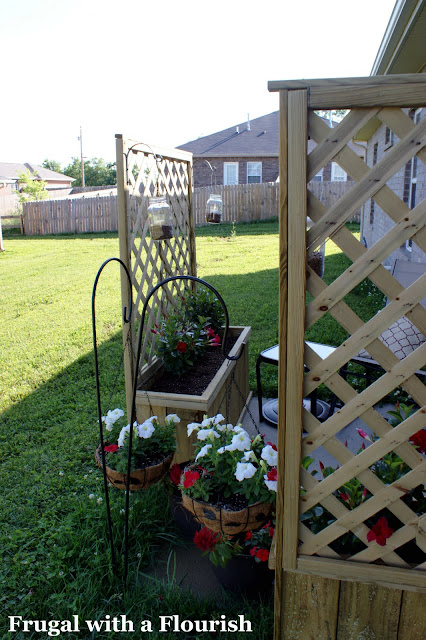So let's get into this shall we. First, this is what you will need
- 1/2 inch treated plywood (I used 3 - 2x4 sheets that would fit in the car, if you have access to a truck you can get just one 4x8 sheet)
- Fence Pickets (I used 5 of the 5/8x5.5x6 that normally around $1.38 a piece)
- 1x2x8 Boards (I used about 8 of these)
- 2x8 Lattice Panels (One of these will make a box)
- Some 1.25" Treated Deck Screws
- Some 1.25" and 1.5" brad nails for your nail gun.
Tool wise you will need
- A Saw of some sort that you can make straight cuts with (I used a jig saw cause that is what we have)
- A Drill
- A Nailgun
- A miter box and saw or a miter saw
Ok. How much of the lumber you use will be directly related to how big you make your boxes. I will give you what I used to make a 44 inch box but I made a smaller one too (33 inches) so email me if that is more your style. To start, take your fence boards and cut them down into 4 - 18 inch pieces. These are 5.5 inches wide so I used that to determine the length and width of my box.
Once you get your fence pickets cut, lay them out and measure what they actually amount to since there is some variation in the width of the boards. Figure out a happy medium with both sides and then go ahead and cut out the sides and edges of your boxes. Mine was 44 inches long by 18 inches high by 11.25 inches wide.
I nailed the box to get it set up and squared and then drilled some wood screws in to get it nice and sturdy.
Oh and don't forget to flip it over and drill some draining holes in the bottom.
Then you just need to line up and nail on your fence board trim. Don't worry about the dog eared pieces of your fence board or any uneven edges - we will cover that with the trim! Oh and the nails will go all the way through the boards and leave some sharp edges. I just bent them down and hammered them flat against the inside of the board.
Now you will want to cut your trim pieces out from your 1x2s using the miter box or miter saw. You only need to add trim to the front and sides of the box.
I did a vertical piece used as a trim around the top and bottom. Then to make the top of the box more presentable, I did another piece horizontally laid across the top to finish it off. (I am sure there is some building term for this - but I don't know what it is!) My long pieces were about 46.5 inches long and my short pieces were around 13.5 inches long. You will want your short pieces to be just long enough to cover to the end of your short side, because your frame will need to attach to the back of your box.
Ta-da! Now you have a box. Notice that you have a flat back edge that you will mount your lattice frame onto.
To build the lattice frame you basically make a sandwich with a tasty lattice inside! I made my frame large enough to accommodate a 42 inch tall piece of lattice. I wouldn't go much larger than that or it gets wobbly. For starters, you make one side of your frame and get it squared.
Next, cut your lattice down, square it up and overlap your edges. Make the other half of your "sandwich" (minus the bottom back of the frame - you will understand below) and then lay over top and nail where the lattice meets the frame on both sides. I would also pop a couple of nails where your lattice overlaps and just bend them down on the back to keep your two pieces together.
To finalize your lattice frame, you will need to cut two long side pieces that will run all the way from the top of your lattice sandwich down the back side of your board. Attach those to the sides of your frame and then mount it onto the back of the box. Put in a few nails into the bottom of the frame and then nail in the legs to the back edge of the box.
See - you will nail it into the back of the box here.
Then add a few wood screws to the back to get it real sturdy and secure.
Now you put your final back frame piece on and your done! I added some bricks and then some gravel in the bottom of mine to create some good drainage. This box took me about two and a half of 64 quart potting soil bags to fill.
So there you go. I realize most of that was as clear as mud - but I am not a carpenter or a designer. Even if I had to do it over again - I would still muddle my way through it because I LEARNED so much about working with wood. Sure, I measured things way more than twice and made cuts that afterwards made no sense. I wasted a little wood - but I learned so much about how what I thought I wanted to do wouldn't be practical when executed. I would highly encourage you to try it out with as little direction as possible so you can LEARN about your tools, measuring and problem solving a carpentry problem. Once you can learn that - you can tackle anything!

























































